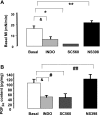Effects of progesterone on motility and prostaglandin levels in the distal guinea pig colon
- PMID: 20501437
- PMCID: PMC2777458
- DOI: 10.1152/ajpgi.00184.2009
Effects of progesterone on motility and prostaglandin levels in the distal guinea pig colon
Abstract
Progesterone (P4) inhibits the gastrointestinal muscle contraction by downregulating Galpha(q/11) proteins that mediate contraction, by upregulating Galpha(s) proteins that mediate relaxation, and by altering the pattern of cyclooxygenase (COX) enzymes and prostaglandins. We aimed to examine whether P4 treatment of guinea pigs in vivo affects basal colon motility [basal motility index (MI)] by altering the levels and actions of PGF(2alpha) and PGE(2). Guinea pigs were treated with intramuscular (IM) P4 for 4 days. The BASAL MI, the PGF(2alpha)-induced contraction, and PGE(2)-induced inhibition of contraction were examined in muscle strips and cells. The levels of PGF(2alpha) and PGE(2) were measured by radioimmunoassay. Treatment with P4 reduced the basal MI, the levels of PGF(2alpha), and PGF(2alpha)-induced contraction. P4 increased PGE(2) levels, and PGE(2) induced relaxation. Pretreatment with IM RU-486 (10 mg/kg per day), a P4 receptor antagonist, 1 h before P4 blocked the actions of P4. The PGF(2alpha) antagonist Al-1180 abolished basal MI and PGF(2alpha)-induced contraction. N-ethylmaleimide, which blocks unoccupied membrane receptors, blocked Ach and VIP actions but had no effect on PGF(2alpha) and PGE(2) effects. A COX-1 inhibitor decreased and a COX-2 inhibitor increased PGF(2alpha) levels; GTPgammaS increased and GDPbetaS decreased the levels of PGF(2alpha). Galpha(q/11) protein antibodies (Abs) reduced PGF(2alpha) levels, and Galpha(i3) Abs blocked its motor actions. Galphas Abs increased PGF(2alpha) but decreased PGE(2) levels. We concluded that P4 decreases basal MI by reducing PGF(2alpha) levels caused by downregulation of Galpha(q/11) and that PGF(2alpha)-induced contraction was blocked by downregulating Galpha(i3). P4 also decreased the basal MI by increasing PGE(2) levels, and PGE(2) induced relaxation by upregulating Galpha(s) proteins.
Figures











Similar articles
-
Progesterone receptor A mediates VIP inhibition of contraction.Am J Physiol Gastrointest Liver Physiol. 2010 Mar;298(3):G433-9. doi: 10.1152/ajpgi.00346.2009. Epub 2009 Dec 17. Am J Physiol Gastrointest Liver Physiol. 2010. PMID: 20019164
-
Characterization of prostanoid receptors mediating actions of the isoprostanes, 8-iso-PGE(2) and 8-iso-PGF(2alpha), in some isolated smooth muscle preparations.Br J Pharmacol. 2000 Aug;130(8):1903-10. doi: 10.1038/sj.bjp.0703522. Br J Pharmacol. 2000. PMID: 10952681 Free PMC article.
-
What regulates placental steroidogenesis in 90-day pregnant ewes?Prostaglandins Other Lipid Mediat. 2007 Aug;84(1-2):54-65. doi: 10.1016/j.prostaglandins.2007.04.002. Epub 2007 Apr 24. Prostaglandins Other Lipid Mediat. 2007. PMID: 17643888
-
Ovariectomy increases the formation of prostanoids and modulates their role in acetylcholine-induced relaxation and nitric oxide release in the rat aorta.Cardiovasc Res. 2009 Nov 1;84(2):300-8. doi: 10.1093/cvr/cvp214. Epub 2009 Jun 30. Cardiovasc Res. 2009. PMID: 19567483
-
The role of prostanoids in urinary bladder physiology.Nat Rev Urol. 2012 Mar 13;9(5):283-90. doi: 10.1038/nrurol.2012.33. Nat Rev Urol. 2012. PMID: 22410675 Review.
Cited by
-
The effects of eupatilin (stillen®) on motility of human lower gastrointestinal tracts.Korean J Physiol Pharmacol. 2014 Oct;18(5):383-90. doi: 10.4196/kjpp.2014.18.5.383. Epub 2014 Oct 17. Korean J Physiol Pharmacol. 2014. PMID: 25352757 Free PMC article.
-
Uncovering the Mechanisms of Chinese Herbal Medicine (MaZiRenWan) for Functional Constipation by Focused Network Pharmacology Approach.Front Pharmacol. 2018 Mar 26;9:270. doi: 10.3389/fphar.2018.00270. eCollection 2018. Front Pharmacol. 2018. PMID: 29632490 Free PMC article.
-
Estrogen rather than progesterone cause constipation in both female and male mice.Korean J Physiol Pharmacol. 2013 Oct;17(5):423-6. doi: 10.4196/kjpp.2013.17.5.423. Epub 2013 Oct 17. Korean J Physiol Pharmacol. 2013. PMID: 24227943 Free PMC article.
-
Effect of progesterone on nitric oxide/cyclic guanosine monophosphate signaling and contraction in gastric smooth muscle cells.Biomed Rep. 2018 Dec;9(6):511-516. doi: 10.3892/br.2018.1161. Epub 2018 Oct 18. Biomed Rep. 2018. PMID: 30546879 Free PMC article.
-
Prophylactic and therapeutic benefits of COX-2 inhibitor on motility dysfunction in bowel obstruction: roles of PGE₂ and EP receptors.Am J Physiol Gastrointest Liver Physiol. 2012 Jan 15;302(2):G267-75. doi: 10.1152/ajpgi.00326.2011. Epub 2011 Oct 28. Am J Physiol Gastrointest Liver Physiol. 2012. PMID: 22038825 Free PMC article.
References
-
- Arkinstall SJ, Jones CT.Pregnancy suppresses G protein coupling to phosphoinositide hydrolysis in guinea pig myometrium. Am J Physiol Endocrinol Metab 259: E57–E65, 1990 - PubMed
-
- Baron Ramirez TH, Richter J. Gastrointestinal motility disorders during pregnancy. Ann Intern Med 118: 366–375, 1993 - PubMed
-
- Bitar KN, Makhlouf GM. Relaxation of isolated gastric smooth muscle cells by vasoactive intestinal polypeptide. Science 216: 531–533, 1982 - PubMed
-
- Cao W, Harnett KM, Behar J, Biancani P. PGF (2α)-induced contraction of cat esophageal and lower esophageal sphincter circular smooth muscle. Am J Physiol Gastrointest Liver Physiol 283: G282–G289, 2002 - PubMed
-
- Chen Q, Chitinavis V, Xiao ZL, Yu PR, Oh S, Biancani P, Behar J. Impaired G protein function in gallbladder muscle from progesterone-treated guinea pigs. Am J Physiol Gastrointest Liver Physiol 274: G283–G289, 1998 - PubMed
Publication types
MeSH terms
Substances
Grants and funding
LinkOut - more resources
Full Text Sources
Research Materials

